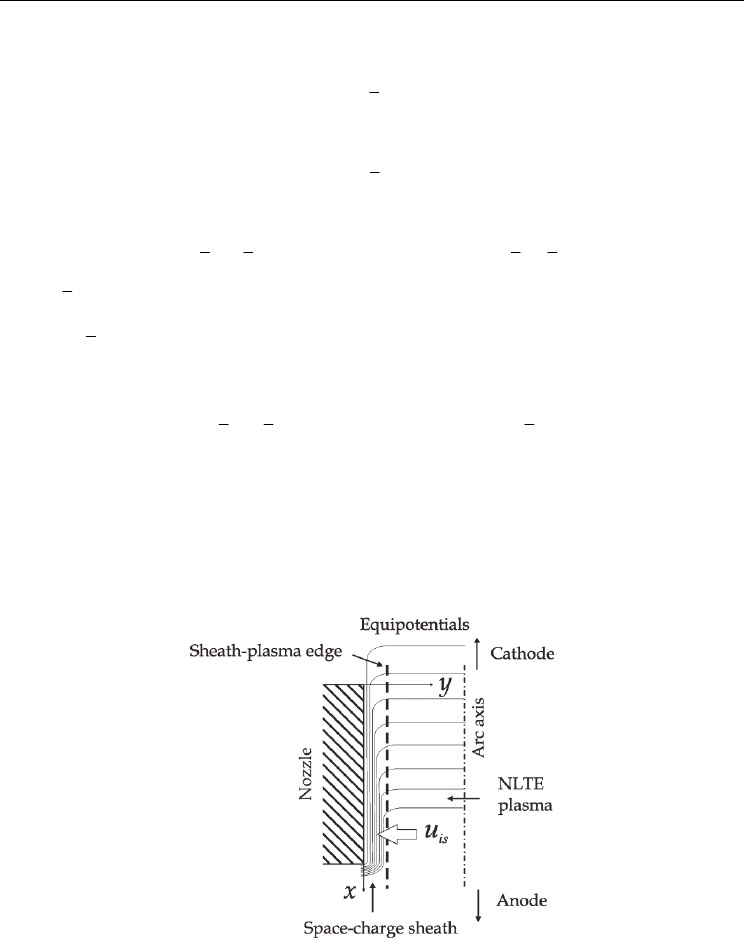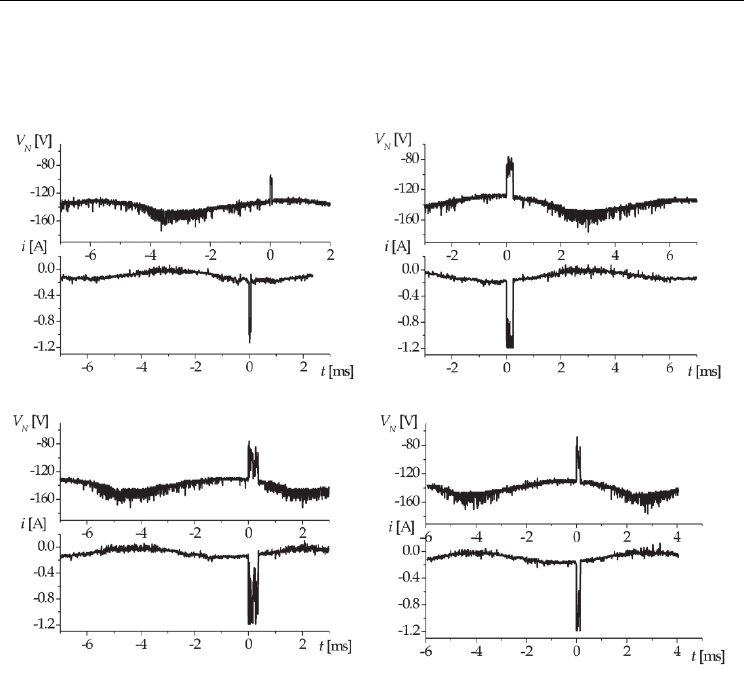Awrejcewicz J. Numerical Simulations of Physical and Engineering Processes
Подождите немного. Документ загружается.


On the Double-Arcing Phenomenon in a Cutting Arc Torch
513
Fig. 4. Sheath thickness along the nozzle wall for the largest nozzle voltage value
experimentally registered for each gas mass flow value. For comparative purposes, the black
circle indicates the sheath thickness value inferred at the nozzle exit using the voltage
breakdown measurement. Taken from Prevosto et al., 2009b.
Fig. 5. Radial profiles of the average (along the nozzle wall) plasma electron temperature as
a function of the radial position measured from the nozzle wall, for the different gas mass
flow values. Taken from Prevosto et al., 2009b.
The spatial distribution of the plasma density is presented in Figs. 6a) and b), for a gas mass
flow rate of 0.32 g s
-1
and 0.54 g s
-1
, respectively. A steep plasma density radial gradient is
shown in Fig. 6a) due to the existence of very large electron temperature radial gradient
close to the nozzle wall (see Fig. 5). Less marked plasma density gradients close to the
nozzle wall are shown in Fig. 6b) for the largest gas mass flow rate registered. In both
figures, the existence of a plasma pressure gradient along the nozzle produces the axial
variation in the plasma density.

Numerical Simulations of Physical and Engineering Processes
514
Fig. 6. a) Spatial distribution of the plasma density close to the nozzle wall for the lowest gas
mass flow experimentally registered. b) Spatial distribution of the plasma density close to
the nozzle wall for the largest gas mass flow experimentally registered. Taken from Prevosto
et al., 2009b.
According to the experimental and theoretical results given above by Figs. 3 to 6, the
physical structure of the electrical boundary layer is strongly influenced by the gas mass
flow rate. The experimental results varying the
m
value show that the current drained by
the nozzle increases (see Fig. 3) when the gas mass flow decreases until finally a breakdown
appears, (see Figs. 4 to 6), in the sense that the
T
e
profile critically depends on the m
value.
When the
m
value decreases, very large T
e
radial gradients (of the order of 10
9
K m
-1
)
produce (through Saha equation) steep
n
e
radial gradients over the last few Debye electron
lengths from the nozzle wall. As a result, the sheath thickness is almost independent on the
VΔ
value, producing an almost constant (and thin) sheath thickness along the nozzle for
low
m
values. Once the sheath thickness is smaller than the critical value, the space-charge
sheath breaks-down leading to double-arcing. A good agreement between the critical value
of the
D thickness at the nozzle exit inferred from the voltage breakdown (under the
Townsend breakdown hypothesis) and the predicted value was found.
4. Numerical model to describe the plasma-nozzle sheath structure at large
negative bias voltages
4.1 Collisional sheath model
As quoted in Section 3, when both plasma and sheath are collisional, and when the ionization
inside the sheath can be neglected, there is a smooth joining between the plasma and the
space-charge layer, thus avoiding the need of the presence of a transitional sheath (the so
called pre-sheath). Thus, the sheath edge coincides with the unperturbed quasi-neutral
plasma. The model geometry showing the collisional space-charge sheath contiguous to the
negatively biased nozzle is sketched in Fig. 7. Since the sheath remains thin as compared with
the nozzle bore size (see Fig. 4) a planar geometry is used (
y and x are the normal and axial
coordinates with respect to the nozzle wall, see Fig. 7). At negative nozzle potentials (of the
order or lower than the floating value), the electron density within the positive sheath remains
small as compared to the ion density, so ionizations inside the sheath can be ignored. The
elastic mean-free-paths for all species are much smaller than the sheath thickness, and
therefore the fluid description applies. Steady-state conditions are assumed.

On the Double-Arcing Phenomenon in a Cutting Arc Torch
515
The governing equations (Goldston & Rutherford, 1995) are given by the ion continuity
equation
()
0
ii
nu∇⋅ =
, (7)
the electron continuity equation
()
0
ee
nu∇⋅ =
, (8)
the ion momentum equation
() () ()
iii ih i
p
inii
nMu u nkT en V nMu u
ν
⋅∇ = − ∇ − ∇ + −
, (9)
where
e
u is the electron fluid velocity, M is the ion mass and e the electron charge. The last
term of equation (9) represents the drag force due to the collisions between ions and
neutrals.
n
u is the neutral fluid velocity and ν
i
the ion-neutral collision frequency for
momentum transfer.
The electron momentum equation
() ()
ee e ee e
p
eem
nmu u nkT en V nmu
ν
⋅∇ = − ∇ + ∇ −
, (10)
where
ν
m
is the effective collision frequency for momentum transfer. Finally, Poisson’s
equation relates the difference between ion and electron densities within the sheath to the
self-consistent potential
()
2
0
p
ie
Venn
ε
∇=− −
, (11)
where
ε
0
is the vacuum permittivity.
Fig. 7. Schematic of the sheath formed between the NLTE plasma and the nozzle wall. Taken
from Prevosto et al., 2009c.
The inertial term can be safely dropped from equation (10) because of the smallness of the
electron mass. Considering the Einstein relation equation (10) reduces to the total electron
flux (Raizer, 1991)

Numerical Simulations of Physical and Engineering Processes
516
eee ee
p
ee
nu n V D n
μ
Γ≡ = ∇ − ∇
, (12)
where the usually small thermo-diffusion term (proportional to
e
T−∇ ) was neglected in
equation (10) as compared to the diffusion term (Raizer, 1991).
μ
e
and D
e
are the electron
mobility and diffusion coefficients. If the nozzle potential is sufficiently negative, due to the
high mobility of the electrons, oppositely directed high diffusion and drift electron fluxes
approximately balance each other to yield a small resultant total electron flux, comparable
with (or less than) the ion flux. Hence
0
e
Γ≈ in equation (12) and the electron density inside
the sheath obeys the relation
()
exp
pps
ees
e
eV V
nn
kT
−
=
, (13)
where
n
es
and V
ps
are the density and the electrostatic potential of the plasma at the sheath-
plasma edge. The neutral particles are considered at rest (i.e.
u
i
>> u
n
). To close the model,
an expression for the ion momentum transfer by elastic collisions must be established. Two
special cases are usually treated in the literature (Franklin, 2002a; Riemann, 2003): constant
ion mean-free-path and constant ion collision frequency. In the first case, the basic
assumption is
p
ih
eV kT
λ
∇>>, which means that the ion drift velocity is much larger than
the ion thermal velocity. Hence the drag force is modeled by
ii
Mu u
λ
− , where the ion
mean-free-path
()
1
in
n
λσ
−
≡ is constant (σ is the momentum transfer cross section for elastic
collisions between ions and neutrals). The collision frequency
iii
u
ν
λ
= depends in this case
on the ion fluid velocity. In the opposite limit the assumption
p
ih
eV kT
λ
∇<< applies. If this
condition is satisfied, the ion fluid velocity is much smaller than its thermal speed. The
collision frequency of the ions is thus determined by their random thermal motion rather
than their fluid velocity and thus
2/
ithi
u
ν
λ
=
. In this relation the ion thermal velocity is
given as
()
8/
th h
ukTM
π
= , and the constant ion collision frequency is independent of the
fluid velocity. The factor 2
1/2
is due to the mutual motion of the ions and neutral assuming
the same temperature for both species (Boulos et al., 1994). The drag force in this case is
given as
ii
M
u
ν
− . Both physical approximations assume that the collision cross section is
independent of the ion fluid velocity. At high pressures, for strongly collisional sheaths, the
constant ion mean-free-path approximation applies close to the wall where the electric field
strength is stronger. On the other hand, the constant ion mobility approximation (constant
ion collision frequency) is physically more accurate at the sheath-plasma edge (where the
electric field is relatively weak). In the transition region, the collision frequency is given by
() ()
22
()
ii
u
λν
ννν
=+ (Sternovsky & Robertson, 2006) where
λ
ν
and
ν
ν
are the ion
collision frequencies in the previously quoted approximations. Following this approach, the
ion collision frequency can be written as
22
2
()
ith
ii
i
uu
u
ν
λ
+
=
. (14)

On the Double-Arcing Phenomenon in a Cutting Arc Torch
517
In spite of the collisional nature of the sheath, inelastic electron collisions are very rare and
also the electron energy transfer to heavy particles by elastic collisions is small. Therefore, it
can be assumed that
T
e
≈ constant inside the sheath, with a value corresponding to the
sheath-plasma edge value.
The model is now closed. In the limit of strong ion-neutral collisions (i.e., the mobility-
limited ion motion approximation) the collision parameter
i
D
λ
is large as was shown in
Subsection 3.3. In such circumstances equation (9) is simplified by neglecting the convective
term on its left hand side. Combining equations (7), (9), (11), (13) and (14), a system of
coupled partial differential equations for describing the mobility-limited ion colisional
sheath was obtained.
()()
0
iix iiy
nu nu
xy
∂∂
+=
∂∂
, (15)
()
0
p
ih
iiixi
V
nkT
en n Mu
xx
ν
∂
∂
−−− =
∂∂
, (16)
()
0
p
ih
iiiyi
V
nkT
en n Mu
yy
ν
∂
∂
−−− =
∂∂
, (17)
()
22
22
0
exp
pps
pp
i
is
is e
eV V
VV
n
e
n
nkT
xy
ε
−
∂∂
+=− −
∂∂
.
, (18)
where the ion collision frequency is given by equation (14). A similar plasma sheath model
was presented (Sheridan & Goree, 1991) for a two-fluid (T
h
<< T
e
, i.e. cold ions) uniform
plasma but under the above quoted extreme collisional approximations. The present model
is further complicated by the axial potential drop along the arc column facing the
equipotential nozzle (see Fig. 7). Also for large ion temperatures (in this problem T
h
is
comparable to T
e
) the thermal ion flux to the wall cannot be neglected; therefore the
diffusive term in equation (9) must be considered.
To solve equations (15)-(18), the appropriate boundary condition (sheath thickness, plasma
density and electron temperature at the sheath-plasma edge, arc voltage and gas pressure
profiles inside the nozzle) were presented in Section 3. At the nozzle wall (y = 0), the voltage
of the nozzle is known (V
N
). The sheath-plasma edge (y = D) coincides with the quasi-
neutral plasma, so
is i e
nnn≡≅ and the voltage distribution is that of the plasma arc
(variable) voltage. Also the radial electric field value at the sheath-plasma edge is very small
(Raizer, 1991), hence
)
0
p
yD
Vy
=
∂∂ ≈. The ions enter the sheath from the plasma with a
velocity normal to the boundary surface given by
()
1/2
is B i Ds
uu
λλ
≈ . At the nozzle inlet
(x = 0) and exit (x = L
n
), open boundary conditions were assumed. So the quantities
ix
ux∂∂
,
iy
ux∂∂
,
i
nx∂∂
and
p
Vx∂∂
are conserved through these surfaces.

Numerical Simulations of Physical and Engineering Processes
518
4.2 Numerical results and discussion
The governing equations (8)-(12) were solved for the electric potential, ion velocity (both
components) and for the ion density, by integrating them numerically using a finite
difference discretization technique in a 100 × 50 uniform grid. An iterative method was
adopted, that continued until the relative difference between two consecutive iterations of
all the physical quantities was less than 10
-5
.
To found the mechanism that triggers the undesirable sheath breakdown, the following
torch operation conditions were used: arc current of 30 A, oxygen gas mass flow of 0.32 g s
-1
and V
n
= -155 V. In such conditions, a thin sheath with an almost constant thickness of
D(z) = 21 μm (see Fig. 4) was formed between the plasma and the nozzle wall.
Fig. 8. Spatial distribution of the electric field strength inside the sheath. Taken from
Prevosto et al., 2009c.
In Fig. 8, the spatial distribution of the electric field strength is presented. As it can be seen, the
electric field value is high, with the largest values along the nozzle wall, varying from 6×10
6
V
m
-1
near the nozzle entrance to about 9×10
6
V m
-1
at the nozzle exit. This enhanced value is
higher than the average field value across the sheath, and is of the order of the breakdown
threshold value. This means that an undesired sheath breakdown could occur close to the
nozzle exit even if the average electric field across the sheath is not strong enough.
The spatial distributions of the ion and electron densities inside the sheath are presented in
Figs. 9 and 10. As it can be seen in these Figs., n
i
drops sharply near the sheath edge and
continues decreasing slowly, while the electron density also shows a very steep drop near
the sheath edge, with a virtually zero value everywhere inside the sheath. The lack of
electrons inside the sheath implies that the electron thermal conduction flux to the nozzle
wall can be neglected. The nozzle wall results thus thermally isolated, in spite of the high
electron temperature in its adjacency. It was found that both the ion and electron densities
decrease when the electrostatic potential decreases. This behavior of n
i
is due to the ion
acceleration at an almost constant ion flux, while the n
e
behavior is due to the fact that the
electrons are related with the electric field according to a Boltzmann equation –equation 13–.

On the Double-Arcing Phenomenon in a Cutting Arc Torch
519
Fig. 9. Spatial distribution of n
i
inside the sheath. Taken from Prevosto et al., 2009c.
Fig. 10. Spatial distribution of n
e
inside the sheath. Taken from Prevosto et al., 2009c.
5. Experimental evidence on the “non-destructive” double-arcing
In Section 1 it was mentioned that a transient (duration < 1 ms), non-destructive, double-
arcing in cutting torches was recently identified (Colombo et al, 2009) by using high-speed
imaging during the torch piercing phase. Gas flow rates and torch stand-off were set to
increase the probability of double arcing. In Colombo’s experiment, the sequence of images
showed several phenomena that can be associated with the double arcing. In particular,
green vapours and silver grey vapours appearing in some of the frames can be correlated

Numerical Simulations of Physical and Engineering Processes
520
with copper (nozzle wall) and hafnium (cathode) vapour emissions, respectively. The
emission of copper vapours could be the consequence of an arc attachment to the nozzle,
while the hafnium vapours exiting the nozzle could be related to a greater erosion of the
hafnium cathode insert in the case of double-arcing due to an arc root attachment instability
on the cathode emissive surface. The high-speed double-arcing images have been time-
correlated with the oscilloscope waveform of the arc voltage drop between the cathode and
the nozzle, and good correspondence was found. The authors then suggested that the non-
destructive double-arcing phenomena during piercing probably occur as a consequence
of the deposition of a small amount of hafnium oxide on the nozzle orifice wall, which
induces a local increase in the radial electric field and hence an increase in the probability
of double arcing. When double arcing occurs, rapid (<1 ms) evaporation of hafnium oxide
with vapour emission from the nozzle restores the previous and normal arc behaviour.
Due to their very short duration, the described phenomena should have a non-destructive
character.
Usually, the power sources used for run cutting torches are poorly stabilized and have large
ripple factors, with RMS values that can amount to 10 % of the time-averaged arc voltages
(Pardo et al, 1999; Prevosto et al., 2008a; 2008b). This is due to the fact that the arc currents in
cutting torches are typically large (of the order of 100 A) which difficult an effective filtering
of the ripple. If a 3-phase transductor type power supply is used, then the fundamental
ripple frequency is 150 Hz and if 3-phase silicon controlled rectifier (SCR) based power
supply is used, then the ripple frequency is 300 Hz. The strong oscillatory components in the
voltage and arc current should produce in turn, large fluctuations in the plasma quantities
that vary at the ripple frequency.
Fig. 11. Ion current and nozzle voltage waveforms for a 7 % RMS ripple level. The Fourier
analysis of the ion current waveform is also shown.
Fig. 11 shows a typical V
N
and i waveforms corresponding to the torch described in Section
3.1 for
1
0.39 gsm
−
=
and a power supply ripple level of 7 %. The gas mass flow value is
close to that producing double-arcing in this torch. It can be seen from Fig. 11 (left) that both
waveforms exhibit high fluctuation levels, reaching for the ion current signal an amplitude
(peak value) of about ≈ 75 % of the time-averaged value. Also, both waveforms are in
opposite phase, a fact that could be related to a negative slope of the current–voltage

On the Double-Arcing Phenomenon in a Cutting Arc Torch
521
characteristic curve of this kind of arcs. The Fourier analysis of the ion current waveform
(fig. 11, right) shows that the signal has a very strong component at 150 Hz, which is the
fundamental frequency of the power source ripple.
Fig. 12. Sequence of ion current and nozzle voltage waveforms with a reduced time-scale
showing arc instabilities associated with the transient double-arcing phenomenon. The arc
operation is close to the full-scale double-arcing.
This experimental result shows that the NLTE plasma inside the nozzle of a cutting torch
results strongly affected by the arc voltage ripple, and thus it is far from the steady state, as
it is usually assumed in the literature (e.g., Gonzalez-Aguilar et al., 1999; Freton et al., 2002;
2003; Ghorui et al., 2007; Zhou et al., 2009, Guo et al., 2010). Such dynamics could explain the
mechanism of formation of the non-destructive double arcing; as it is shown with detail in
Fig. 12. In these oscillograms (with a reduced time-scale), the ion current and nozzle voltage
are shown for the same arc operating conditions (i.e.,
1
0.39 gsm
−
=
and a ripple level of 7
%). The sequence of images shows marked arc instabilities (during time intervals < 1 ms)
that can be associated with the transient double-arcing phenomenon. It should be noted that
such instabilities approximately coincides with the negative peak value of the ion current;
thus supporting the hypothesis that the “non-destructive” double-arcing phenomenon is
related to the plasma dynamics inside the nozzle. Another argument to support this
hypothesis is the quite high repeatability of the phenomenon.

Numerical Simulations of Physical and Engineering Processes
522
6. Final discussion and conclusions
In this work, we have presented a study of the arc plasma-nozzle sheath structure, which is
the region where the double-arcing takes place.
The starting point was obtaining a physical interpretation of the RMS current-voltage
characteristic of the nozzle that led to predict the thickness of the quoted sheath in terms of
the gas mass flow value. Thus, a Towsend-type breakdown of the neutral gas inside the
sheath was suggested as the double-arcing trigger. The predicted gas mass flow value that
produced a breakdown was in good agreement with the experimental m
that actually
produced double arcing in our torch.
A detailed study of the sheath structure by developing a numerical model for a collisional
sheath was also presented. This model allowed obtaining profiles of the electron and ion
densities and electric field along the sheath, which confirmed the Towsend-type breakdown
of the sheath as the most likely mechanism to produce double-arcing. In particular the
breakdown was based on the local electric field strength intensification at the nozzle wall
close to the bore exit. This enhanced field could be strong enough to trigger a breakdown
even if the average electric field across de sheath is not strong enough.
The proposed mechanism is quite different from that previously found in the literature
(Nemchinsky (1998) and Nemchinsky & Severance (2006)), in which it is suggested that the
voltage drop inside the nozzle is concentrated across the cold quasi-neutral plasma layer
that separates the hot plasma and the nozzle. Note that our hypothesis implies that the
thickness of the space-charge layer (where almost all the electric field is concentrated) is
shorter than the cold gas envelope (i.e., the electric field cannot penetrate deep inside such
envelope), thus the average electric field in the nozzle vicinity rises (
VD≈Δ ). The cold gas
envelope hypothesis was recently adopted by Guo et al. (2010). Its thickness was arbitrary
defined as the contour corresponding to 7000 K (≈ 0.5 mm). However, the electric field
cannot penetrate inside such envelope since the space-charge layer at this temperature value
is much smaller than such gas envelope.
A transient (duration < 1 ms), double-arcing in cutting torches –the so called “non-destructive”
double-arcing– was recently identified (Colombo et al, 2009) under torch operating conditions
close to those producing double-arcing. Similar observations of this phenomenon have been
presented in this work. Due to their very short duration the described phenomena can have a
non-destructive character. Although the literature proposed hypothesis (Colombo et al., 2009;
Nemchinsky 2009) assumes a transient arc voltage rise due to dielectric films deposited on the
nozzle surface (which are later either carried away by the gas flow or are burned out); our
experimental observations suggest that such a phenomenon is more likely related with the
dynamics of the space-charge sheath contiguous to the nozzle due to the arc power source ripple.
7. Acknowledgement
This work was supported by grants from the Universidad de Buenos Aires (PID X108),
CONICET (PIP 5378) and Universidad Tecnológica Nacional (PID Z 012). H. K. is member of
the CONICET.
8. References
Blank, J. L. (1968). Collision-dominated positive column of a weakly ionized gas. Phys.
Fluids, 11, 1686.
